THE SABBATH DAY
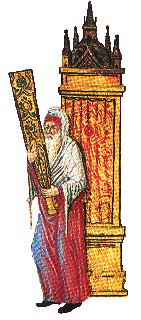
|
Italy c.1470 CE. |
The custom of reading from the Torah on Saturday mornings is so old that it is difficult to be certain when it first started. Moses commanded that it should be read at the end of every seventh year. And Moses commanded them, saying, At the end of every seven years, in the time of the year of release, in the Feast of Booths, When all Israel has come to appear before the Lord your God in the place which he shall choose, you shall read this Torah before all Israel in their hearing.1. Ezra read a scroll containing Moses' teaching to the people in Jerusalem on the 1st of Tishri.2. But the Bible does not state that it was read regularly each Sabbath. But by 200 CE it was a well established custom 3. At a slightly earlier date (early 2nd Century CE) the practice is mentioned as old in the Christian New Testament. 4.

|
Torah Scroll. |
In Talmudic times the synagogues of Babylon and Palestine had different practices concerning the reading from the Scroll. In Palestine they read the complete scroll on a three-year cycle while in Babylon the complete scroll was read in one year. The Babylonian system has been widely accepted. But Benjamin of Tudela recorded that the three-year cycle was still used in one of the Cairo Synagogues in the 12th cent. CE.
The Bible says that they read in the book in the Torah of God clearly, and gave the interpretation, so that they understood the reading. 5. This led to the practice of having a translator (meturgaman) to explain the readings. The Targumim (Aramaic translations) were probably written for this purpose.
(1.) Deut. 31, 10-11. (2.) Nehemiah 8, 1ff. (3.) Megillah 3, 4f. (4.) Acts, 15, 21. (5.) Nehemiah 8, 8.
ALIYOT.
 (Aliyot) means people going up. When Ezra read from the scroll he was described as standing on a wooden platform. 6. It is the custom to call people up to the scroll reading using their Hebrew names. Originally they used to read from the scroll, now it is usual for them just to say the blessings. But the custom of reading is still carried out at a Barmitzvah.
(Aliyot) means people going up. When Ezra read from the scroll he was described as standing on a wooden platform. 6. It is the custom to call people up to the scroll reading using their Hebrew names. Originally they used to read from the scroll, now it is usual for them just to say the blessings. But the custom of reading is still carried out at a Barmitzvah.
The number called up follows the rule: This is the general rule: on any day which has a Musaf and is not a festival four read; on a festival five read; on the Day of Atonement six read; on Sabbath seven read7. Of the number called up the first is a Cohen (priest), the second a Levite and the remainder are other Jews. The following rules were laid down in the interests of peace. a priest is called up first to read the law and after him a Levite and then a lay Israelite…8.
(6.) Nehemiah 8, 8. (7.) Megillah 4, 1 (8.) Gittin, 5, 8.
WOMEN GIVEN ALIYOT?

| India. Also used in Iraq. |
In the Talmud it says: Our Rabbis taught: All are qualified to be among the seven [who read], even a minor and a woman, only the Sages said that a woman should not read in the Torah out of respect for the congregation.9. Why should the calling up of a woman be disrespectful to the congregation? Torah readings are at fixed times (Mondays, Thursdays and Saturdays) and the reading is a positive commandment. Women are not bound to observe positive commandments at a fixed time, while this is required of men. By giving the mitsvah to a woman who is not duty-bound to do so, it might imply that none of the men present were fit to carry out the mitsvah. Would people really think that today? It could be argued that a congregation gains more respect not less, if it honours its female members. There are others who raise objection to men hearing a female voice at prayer. If this had been a legal decision rather than male prejudice, then the Rabbis would not have said that a woman is qualified to be called up, and the sages would have stated it as their reason why they thought a woman should not read, instead of giving the rather vague respect for the congregation.
Calling up of women is only practised in Liberal, Reform and some Masorti Synagogues. Orthodox synagogues do not call women to the Torah except in all female congregations.
(9.) Megillah 23a.
TORAH SERVICE
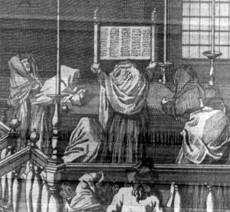
| Amsterdam, 1724. |
The scroll or scrolls to be read are taken from the Ark and taken in procession round the Synagogue and then placed on the reading desk. The members of the congregation turn to face the scrolls, as turning ones back would imply disrespect. Congregants bow and sometimes touch the fringe of their Tallit (prayer shawl) on the scroll and in effect transfer a kiss to it. In this way they show their love and respect for the contents of the scrolls rather than to the scrolls themselves. The procession serves to bring the Torah closer to the people and the people closer to Torah; but originally this provided a practical means of taking the scroll to a central reading desk.
The covers are removed from the Torah and the scroll is elevated and turned in various directions so that all can see the text. The Sephardim raise the scroll both before and after the reading, while the Ashkenazim do so only after the reading. The lifting up is called Hagbah.
People are called up to the scroll reading by their Hebrew names. Blessings are said over the Torah and Haftarah. These thank God for giving us the Torah and the string of Hebrew prophets, they do not bless the scroll or prophets. For by the nature of their contents, they are already holy.
HAFTARAH.
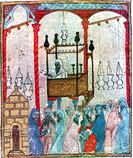
| Synagogue, 14th. Cent. |
 (Haftarah), the name given to the reading from the Prophetic books which follows the Torah reading. This custom is so old that its origin is unknown and even the derivation of the name is far from certain.10. It is thought to come from the Hebrew root patar which can mean either to end or to open up. Most people take it to mean that this the last reading just before the end of the service. However, there are some who think that the prophetic reading was deliberately chosen to link up with the subject matter of the scroll reading. A preacher could then use the prophetic text to elaborate on the meaning of the Sidra, in much the same way as many of the midrashim use a supplementary text to open up or bring out a meaning from the primary text. Many of the Haftarot contain a name, phrase, subject matter or style, which seem to link with the Sidra (portion for the week). In the 14th century CE it was suggested that the prophetic readings started when oppressors forbade the reading of the Torah11., while yet others suggest that the reading was introduced to counter the views of the Samaritans, who regarded only the Pentateuch as holy12.. It has also been suggested that the Pharisees introduced the reading of the Haftarot to counter the view of the Saducees who laid great emphasis on the Torah.
(Haftarah), the name given to the reading from the Prophetic books which follows the Torah reading. This custom is so old that its origin is unknown and even the derivation of the name is far from certain.10. It is thought to come from the Hebrew root patar which can mean either to end or to open up. Most people take it to mean that this the last reading just before the end of the service. However, there are some who think that the prophetic reading was deliberately chosen to link up with the subject matter of the scroll reading. A preacher could then use the prophetic text to elaborate on the meaning of the Sidra, in much the same way as many of the midrashim use a supplementary text to open up or bring out a meaning from the primary text. Many of the Haftarot contain a name, phrase, subject matter or style, which seem to link with the Sidra (portion for the week). In the 14th century CE it was suggested that the prophetic readings started when oppressors forbade the reading of the Torah11., while yet others suggest that the reading was introduced to counter the views of the Samaritans, who regarded only the Pentateuch as holy12.. It has also been suggested that the Pharisees introduced the reading of the Haftarot to counter the view of the Saducees who laid great emphasis on the Torah.
The choice of Haftarot has never been universally accepted by all Jewish communities. In the early period when the Palestinian and Babylonian Jews used different cycles of readings of the Torah, their haftarot were also different. Today there are still a few differences between the readings used by Ashkenazim and Sephardim on some weeks. While communities in Israel do not read the haftarot which diaspora Jews use for second days of festivals, as they do not observe second days.
The person who reads the Haftarah is called Maftir, and is often called up for the last portion of the scroll reading.
(10.) Early references are: Acts 13, 15, Tosefta Megillah 4, 1, and Megillah 4, 10. (11.) Abudraham. (12.) Beuchler.
WORK.
a) The Old Approach. The Ten Commandments state that we should not do any work on the Sabbath. Work is not defined in the Bible; but there are a few references to forbidden Sabbath activities in trade 35. and gathering sticks 36., (see also LIGHTING FIRES.). The later Rabbis pointed out that the description of building the Tabernacle in Exodus 35 vs 1 - 3 is interrupted by some verses describing the need to observe the Sabbath and then the description of the building continues. They deduced from this that the building of the Tabernacle stopped on the Sabbath. And therefore they identified 39 types of activity involved with the construction, which they decreed are forbidden on the Sabbath. 37. From this tenuous thread of argument is suspended the whole weight of legislation about work forbidden on the Sabbath day. (Tannaitic Rabbis recognised this and said that the rules of the Sabbath… are as mountains hanging by a hair.38.) Later in the Talmud, these 39 types were examined in greater detail and activity was further restricted.
b) More Recent Approach. The concept of "work" should be interpreted in the spirit rather than the letter ... I would impress upon parents the grave importance of all work which children do on week days being suspended on the Sabbath … The boy that does not learn drawing on week days may draw on Saturday. The boy who is learning English history on week days must read no history on Saturday. And so on. (Claude Montefiore) 39. This was addressed to parents bringing up children; but adults should apply the same principle to themselves on such matters as DIY, hobbies or pastimes. It is necessary to follow the original spiritual approach to the Sabbath rather than the later legalistic interpretations. This approach requires each individual to exert a deliberate thought and effort in order to experience the peace, joy and holiness of the Sabbath.
(35) Nehemiah 13, 15-17 (36) Numbers 15, 32-36 (37) Mishnah Shabbat 7, 2. (38) Hagigah 1, 8. (39) Outlines of Liberal Judaism p. 258.
LIGHTING FIRES.

Moses commanded the congregation You shall not kindle (or burn) a fire in your dwellings on the Sabbath.40. In Numbers 15, 32-36 it describes how while they were in the wilderness a Jewish man was found gathering sticks for a fire. After consulting God, Moses decreed that the man should be stoned to death for this. Two things resulted from this story. The first was that it became a Sabbath rule that no fires were to be lit on the Sabbath day. The Karaites had no fires burning, but Rabbinic Judaism permitted fires provided they had been lit before the Sabbath started. (see also CANDLES, BLESSING AND LIGHTING) Later any kind of kindling or starting fires was forbidden. And so the most Orthodox of Jews will not switch on an electric light, and will even remove the light bulb from refrigerators before the Sabbath, so that during the day they can open the door without kindling a light. Today, many now rely on pre-set timer switches to switch on electric lights and appliances. The other thing that resulted was that some extremely Orthodox believe they have a right to throw stones at those they find breaking the Sabbath.
(see also SHOBBOS GOY.)
(40) Exodus 35, 3.
SHOBBOS GOY.
A Yiddish term once used for the non-Jews who used to come into their homes and build up their fires for them in winter.41. In the 20th century gentiles in the East End of London were still being asked in to do this and were often paid for it. Yet 2000 years previously, the Qumran community forbade it 42.. It is commanded that one's man servant and maid servant should also rest. But this was a legal fiction to get round the law. If one's gentile neighbour should out of the kindness of his heart come in and tend your fire, why should you stop him? And if he should pick up the money which had been left for him on the mantlepiece, was there anything wrong in that?
(See also LIGHTING FIRES. and LEGAL FICTIONS.)
(41) Shabbat 16, 6. (42) DSS Damascus Document.
TRAVELLING
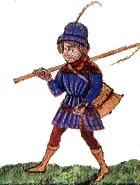
|
c. 1470 CE |
In the story about the mannah where a double portion was provided on a Friday, there occurs the following phrase: let no man go out of his place on the seventh day. 43. This was later interpreted to mean that one should not travel far from home. The distance was stated in the Mishnah 44. as 2000 cubits (roughly 1 kilometre) from one's town (based upon Numbers 35, 5.); but this law is at least a century and a half earlier than the Mishnah as it was observed by the Essenes of Qumran.45. This For the way to get round this law (see also ERUV TECHUMIM)
The Orthodox do not permit the use of a car on the Sabbath as the internal combustion engine involves ignition which is lighting a fire. This causes a problem for Jews living some distance from their synagogue. Is it better to observe the rule and stay away from public worship with ones community or to ignore the rule and gain the benefit from the prayers, the study and the social contact provided by the synagogue? Many Jews opt for the latter, as deep down they believe that this is what God wants of them. All, from the ultra-Orthodox to the most radical Reform, would condemn as hypercritical those who drive to synagogue on the Sabbath and park round the corner, pretending they had walked there. Who do they think that they are fooling? Is it God, their consciences or just their fellow congregants?
(43) Exodus 16, 29. (44) Eruvin 5, 6. & Eruvin 51a, (45) DSS. 4Q251 and Damascus Document.
ERUV CHATSEROT.
Meaning the mixing of courtyards. One of the 39 types of work forbidden on the Sabbath was carrying. (see also WORK) Clearly carrying things in ones home was permitted, but carrying things into or out of buildings, or in the public domain was considered as work. At least 150 years before the Mishnah The Qumran community the carrying of things into or out of buildings on the Sabbath.46. The question was: where does the home stop and the public domain begin? If a number of houses were built round a closed courtyard, then the Rabbis declared them to be a single unit, and carrying could take place within the whole area. This lenient decision led to a legal fiction mentioned in the Mishnah 47., which nullified the original law. In some towns and cities, Jews suspended ropes round large areas on high poles. This for legal purposes turned large zone into a courtyard. Once this had been done anyone was permitted carry objects or push prams, which had been previously forbidden on the Sabbath.
(46) DSS. 4Q251 & Damascus Document. (47) Eruvin 1, 1 ff.
SAVING LIFE ON SHABBAT.
This emphasis on legalism needed a counterbalance. So the Rabbis developed the concept of  (Pikuach Nefesh), Regard for Human Life. This states the general rule that if there is a possibility of danger to human life, every danger to human life suspends the [laws of the] Sabbath.48. The reasons upon which this rule is based are found in the Gemara R. Simeon b. Menassia said [quoting Exodus 31, 16]: "And the children of Israel shall keep the Sabbath to observe the Sabbath" The Torah said: Profane for his sake one Sabbath, so that he may observe many Sabbaths. Rab Judah said in the name of Samuel: If I had been there, I should have told them something better than what they said (quoting Leviticus 18, 5 which says: ) "You shall keep My and My laws which if a man do he shall live by them," [which implies:] but he shall not die by them.49.
(Pikuach Nefesh), Regard for Human Life. This states the general rule that if there is a possibility of danger to human life, every danger to human life suspends the [laws of the] Sabbath.48. The reasons upon which this rule is based are found in the Gemara R. Simeon b. Menassia said [quoting Exodus 31, 16]: "And the children of Israel shall keep the Sabbath to observe the Sabbath" The Torah said: Profane for his sake one Sabbath, so that he may observe many Sabbaths. Rab Judah said in the name of Samuel: If I had been there, I should have told them something better than what they said (quoting Leviticus 18, 5 which says: ) "You shall keep My and My laws which if a man do he shall live by them," [which implies:] but he shall not die by them.49.
Probably the earliest example of setting the Sabbath laws aside was in 167 BCE when Mattathias and the Hasmoneans declared that it was permitted for their followers to fight on the Sabbath day to defend them selves from attack.50.
Sadly, some of the more extreme of Orthodox Rabbinical authorities hold that Pikuach Nefesh only permits the setting aside of Sabbath laws to save the lives of Jews. In Israel the medical services ignore them and work to save lives of all people on the Sabbath.
(48.) Yoma 8,6. (49.) Yoma 85a and b. See also Ketubot 5a. (50.) 1 Maccabees 2, 41.
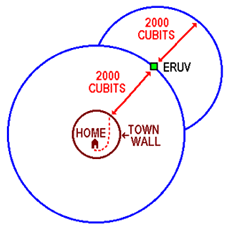
ERUV TECHUMIM
Meaning an Eruv of borders. It is not permitted to walk more than 2000 cubits from ones town on Shabbat. (see also TRAVELLING) The legal fiction employed to double the distance was to set up a temporary home outside town before the Sabbath in the direction you wished to go. You could then walk 2000 cubits to your temporary home and another 2000 cubits on the far side. A temporary home was established by placing food for two meals there. 51. Both the law and the legal fiction date back at least to c. 200 CE when the Mishnah was compiled.
(51) Eruvin 5, 7, and 8, 1, etc.
LEGAL FICTIONS.
Orthodox believe that at Mount Sinai, God gave to Moses not only the written Torah but also oral interpretations and laws as well. They believe that these oral laws were faithfully passed down through centuries and finally they were written down in the Mishnah and Talmud. So the Rabbinic laws and statements that were recorded have divine authority. They accept without questioning Rabbinic statements like "Moses received Torah on Sinai, and handed it on to Joshua, and Joshua to the elders, and the elders to the prophets, and the prophets handed it on to the men of the Great Assembly." (Avot 1, 1.)
Modern scholarship teaches that both historical evidence and internal Biblical evidence show that there were gaps in the passing on of oral traditions. For example:
- Passover sacrifice was reinstituted in the reign of Josiah after a gap of several centuries for it says The Passover sacrifice had not been offered in that manner in the days of the chieftains who ruled Israel, or during the days of the kings of Israel and the kings of Judah.52.
- Circumcision was not carried out for 40 years. Now whereas all the people who came out of Egypt had been circumcised, none of the people born after the exodus, during the desert wanderings, had been circumcised.53.
- Succot. Were not built for some 700 years or so. The whole community that returned from the captivity made booths and dwelt in booths - the Israelites had not done so from the days of Joshua son of Nun to that day.54.
Many scholars believe that much of the Oral Law dates back only as far as the early Pharisees in the 3rd Century BCE. For it was they who introduced the promulgation of new laws based upon the study and interpretation of the Biblical text. 55. While many other modern scholars would accept the views of Higher Criticism that not all of the words of the first five Biblical books date back to the time of Moses. So just because a law is in the five books attributed to Moses does not necessarily mean that it goes back to Sinai and has the authority of Divine dictation.
Many modern Jews believe that although much of the five books of Torah was inspired by God and contains eternal truths. However there are also parts which were written by human beings and which suffer from the imperfections which we human beings are liable to have. The authority of the Book, so far as it goes, is its worth, and so far as that worth reaches, so far reaches the authority. The book is not good because it is from God; it is from God so far as it is good. The book is not true because it is from God; it is from God so far as it is true.56.
An Orthodox Jew, who accepts the Divine authorship of the Written and Oral, believes that the most important thing in life that he can do is to follow all the commandments laid down there in the minutest detail. But as the Mishnah already describes ways in which he can get round some of these commandments, he feels that the methods of avoidance also have Divine sanction.
Many Reform and Liberal Jews believe that these legal loopholes are just playing games with Torah. If it is the Divine will that we should not light a fire or travel more than a certain distance on the Sabbath, then finding a clever legal way round the original command is really against God's will. Rather than showing respect for Torah, these legal games demean the whole concept of Torah and make it liable to be ridiculed.
All this highlights the differences in approach between Orthodox and Reform Jews. Each individual Jew or Jewess should try to understand what is that God requires of them, and then should apply this to their daily life. And any Jew who sincerely follows his religious beliefs in this way should be respected by sincere fellow Jews of any Jewish background.
(52.) 2 Kings 23, 22. (53.) Joshua 5, 5. (54.) Nehemiah 8, 17. (55.) J.Z. Lauterbach, Rabbinic Essays: The Saducees and Pharasees. (56) C.G.Montefiore, Manifesto of Jewish Religious Union, 1909.
PEACE AND JOY.
Many of these laws are concerned with what one should not do on the Sabbath; but the positive aspect is really more important. Most people find that their workday life is concerned with the material aspects of the world. Very often their work is such that they have to work long hours under considerable pressure. The Sabbath day provides a break in this routine. It gives us time to think of other things, it provides an opportunity for rest and spiritual refreshment. The Bible said that Man does not live by bread alone.57. It lets us spend time with ones family and friends. Some jokingly say that the only time that they see their children is on Shabbat. The observance of the Sabbath is perhaps even more important for those in the modern world than it was for our ancestors. There is a therapeutic aspect of the Sabbath.
The German poet Heine said that during the week a Jew was like a dog; but on the Sabbath he was transformed into a prince.58. Although times have changed, the Sabbath still gives us a spiritual uplift.
How then should one spend the Sabbath? Each person must find their own means of making the day holy. It may be by study, it may be visiting a sick or lonely person. It may just be by being with ones family. It is not that the seventh day is automatically holy, but rather that we have to spend thought and effort to make it holy. And when we do this we experience the rewards of the joy and peace which accompany the Sabbath.
(57.) Deuteronomy 8, 3. (58.) Princess Sabbath, 1851.
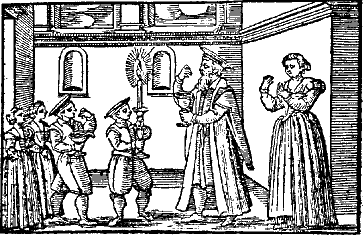
|
HAVDALAH.
 Havdalah (making a distinction) is the ceremony which marks the end of the Sabbath. R. Shaman b. Abba said to R. Johanan said: It was the Men of the Great Assembly who instituted for Israel blessings and prayers, sanctifications and havdalah blessings.59. This probably meant that by Talmudic times it was a very old practice. The ceremony developed into one that was like a mirror image of the Sabbath Evening Kiddush, with both wine and candles. However, while the candles are lit in a Friday night they are extinguished at the end of the Sabbath. The ceremony takes place after sunset on Saturday at any time after three stars are visible. (to avoid making a mistake on timing.)
Havdalah (making a distinction) is the ceremony which marks the end of the Sabbath. R. Shaman b. Abba said to R. Johanan said: It was the Men of the Great Assembly who instituted for Israel blessings and prayers, sanctifications and havdalah blessings.59. This probably meant that by Talmudic times it was a very old practice. The ceremony developed into one that was like a mirror image of the Sabbath Evening Kiddush, with both wine and candles. However, while the candles are lit in a Friday night they are extinguished at the end of the Sabbath. The ceremony takes place after sunset on Saturday at any time after three stars are visible. (to avoid making a mistake on timing.)
The three symbols of Havdalah are:
- A CUP OF WINE. Symbolic of the joy of the Sabbath.
- A PLAITED CANDLE. The blessing refers to "Lights of the Fire" in the plural. So that more than one candle is required. So several wicks are plaited together to enable one to extinguish them at the same time.
- A SPICE BOX. This is passed round for all to smell. This implies that although the Sabbath is over, the sweet influence of the day remains with us into the working week. Another explanation is based on the Talmudic saying Resh Lakish said: Man is given an additional soul on Friday, but at the termination of the Sabbath it is taken away from him.60. and the aroma is a compensation for the loss of the extra soul. A third explanation was that during the Sabbath one could not burn spices to make a pleasant smell as they did on weekdays, but after the Sabbath they immediately pass round cold spices for that purpose.
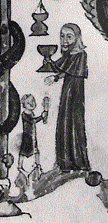
|
14th cent. CE. |
It is usual to spill some of the wine into a saucer. Some see this as the Sabbath influence as spilling over into the secular week, and others as a sign of the blessing of plenty. The candle is dipped into the wine in the saucer, which extinguishes it. If this ceremony is carried out in a room where the only light comes from the Havdalah candle, the room suddenly goes dark and dramatically illustrates that the special light of the Sabbath has come to an end. At this point it is usual to wish each other  (Shavua Tov!) - Have a Good Week!
(Shavua Tov!) - Have a Good Week!
The picture of Havdalah in Venice (above right) shows the youngest child holding the candle in a large candle holder. The peculiar position of everyone's hands shows them looking at the nails on their half-clenched fingers. Some see this as creating shadows which, as the blessing says, makes a distinction between light and darkness. Others explain it by saying that after saying a blessing over light one immediately makes use of the light.
(59.) Berachot 33a. (60.) Ta'anit 27b.
| FOR ALPHABETICAL INDEX OF CUSTOMS |